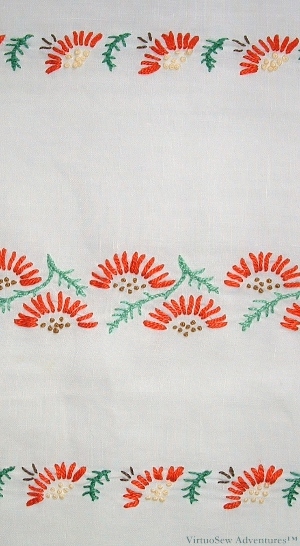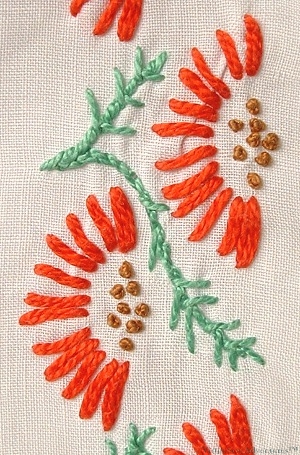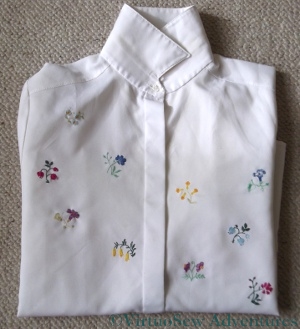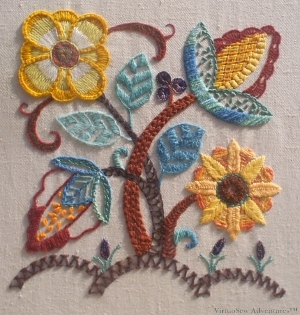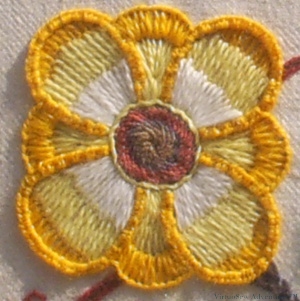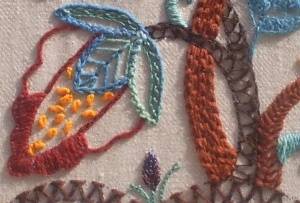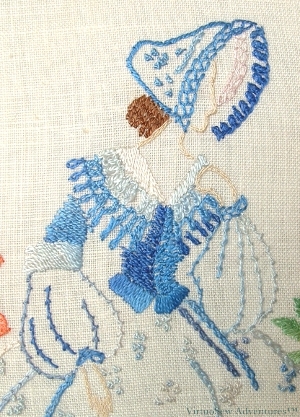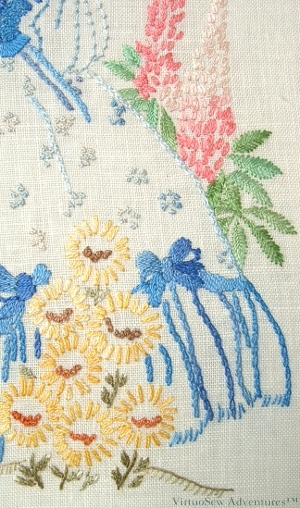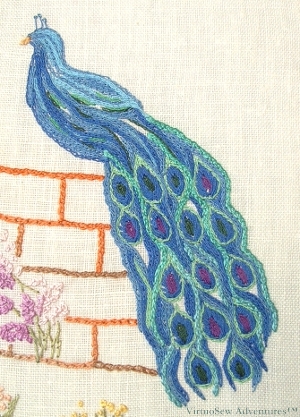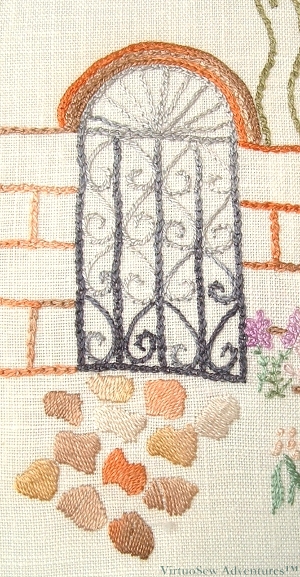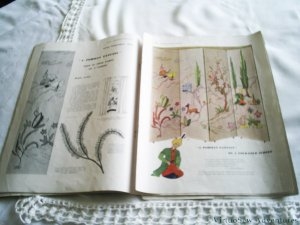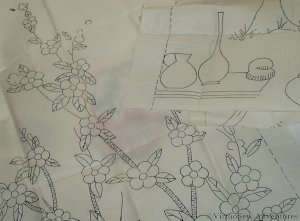Tag: transfers
Another early piece
I worked on this very early in my embroidering career. The design comes from a free transfer in one of the Needlewoman Magazines my Grandmama gave me (September 1934, since you asked!), and I worked it to go with the curtains in my bedroom which were a wonderful Regency strip in red and gold. It’s a table runner – I used it on my dressing table – and it is very nearly two feet long.
The original article to accompany the transfer described several different colourways and a whole range of sketches of suggested uses. There was the idea of sprigging (organdie) curtains with the single motif, embroidering a sunshade, a bag (linen), a luncheon set, gloves, embellishment on the brim of a hat, even on a nightdress or slip (silk of course!). Sometimes I wish I had lived in the Thirties!
I used some fine linen – essentially altar linen, a fine even-weave, nothing fancy, and embroidered it using pearl cotton. As you can see from the close up, pearl cotton really was rather too heavy for the fabric, but then I liked it at the time, and if you don’t like what you’re doing, it tends to take longer to finish.
I should have had the courage of my convictions and worked the French Knots as seed stitches (I hated French Knots at the time – possibly because I wasn’t very good at them). There are only three stitches – straight stitch, stem stitch, and French Knots, so it was very easy and simple to work.
I simply had to keep going at it. That’s when I discovered that I’m not very happy doing repetitive embroidery!
And – in case you are interested – although the linen was old when I worked the embroidery, it has in fact outlasted the bedroom curtains… They don’t make fabric like that anymore!
A flowered blouse
As Spring shows her head after the chill of Winter, I am beginning to fish out clothes other than bulky winter woollies. This is a simple polyester blouse I embroidered some years ago when I had time, an itch to embroider, but absolutely no money to buy fabric.
I used a Free Transfer from The Needlewoman of January 1934 (from the boxful that Grandmama gave me), showing sprigs of flowers which they suggested might be used for lavender bags, traycloths, handkerchiefs, or underwear (if only I had the time and skill to make lovely silk embroidered undies!). The silk threads came from my stash (even fifteen years ago my stash was extensive and varied!), and in fact I think the whole idea of the project was that I wanted to use those threads in particular.
I’m not really a “floral”-type person, or at least the florals I stitch tend to be quite heavily stylised, and I’m also not someone who likes perfect symmetry. So I snipped out some elements from the transfer and arranged them irregularly on the front of the blouse. Once they were transferred, I arranged the threads, so each colour appears on each side of the button placket, but not on the same flower sprig.
I will provide close ups in another post, when I have worked out how to format them!
Jacobean Work Panel
This design is from a transfer I picked up in a hurry a few years ago so as to have something to stitch while on holiday. It went swimmingly for a while and then ran into a brick wall and I have only just finished it.
The threads are wool and cotton, with a little bit of rayon. I intended the panel as a companion for my Jacobean Firescreen, so the colours of teal, brown and gold more or less chose themselves. There aren’t as many overdyed threads as I sometimes use, but that allows me to experiment all the more with the stitches.
Since I picked it up again, I’ve used it to play with some of the stitches which are new to me that I found in my copy of Yvette Stanton‘s Right Handed Embroiderer’s Companion. The whole thing became much more fun at that point!
So here, for example, the centre of the flower is worked in Spiral Trellis Stitch. I used a single strand, round thread overdyed in rust brown and purple, and although it was hair-raising to stitch, because I felt I was twisting myself in a spiral at the same time, I think it is rather successful. It’s not perfect, but I’ll do better another time, and I do think it looks rather good!
The dark brown rather lacy stem is worked in Mountmellick thorn stitch – another new one. Here I used one strand of a three-stranded cotton yarn. I think it would look better in a slightly heavier yarn, but it was fun to do and I will use this stitch again. The calyx of the strange fruit shows two of my favourite stitches – Cable Chain and Portuguese Knotted Stem.
I’m not entirely content with either of the flowers, but as I’m not sure why I shall leave well alone. Both of them have been unpicked at least twice, and I don’t want to wear out the fabric… Still, now it’s finished, I enjoyed working this!
Did You But Hear My Lady..?
The Lady in the Garden, again came from a transfer, and was stitched as a companion to the Peacock, and a homage to Grandmama’s Lady. Unlike Grandmama, I made no effort to provide the lady with lovely graduated ruffles – if I am honest, because I really didn’t think I would finish them if I tried! Instead her dress is sprigged with flowers (in Sorbello stitch, which was rather fun!) and only ruffled around the hem.
Because I conceived of the Lady and the Peacock as a pair, I emphasised the flower colours around the lady, and worked some elements of her dress in one of the blues I used for the peacock.
The inside edge of the bonnet is ornamented with Rosette Chain stitch, while the outside is edged with closed feather stitch. This would also have been an ideal opportunity to use bonnet stitch, but I didn’t think of it in time! I also used Rosette Chain Stitch for the ruffles on the the lady’s collar. I like to use a variety of stitches – the trick is not to use so many that the eye becomes bewildered. Using a basic stitch and its variations is one way to maintain some sense of uniformity, as is keeping a small colour palette.
The bodice is in Bokhara Couching, and the sleeves outlined in coral stitch. I’m surprised at how well this works – it should look thorny, and heavy, but somehow manages to evoke an airy gauze sleeve. How does that work?
The bows above the flounce of the skirts are in satin stitch, and the impression of the flounce is given by lines of chain stitch. Almost all the visual weight of the dress is at the bottom, and the airy sprigging on the skirt allows the flowers to take some of the limelight.
Again the stitching is simple – fishbone stitch for the leaves, detached chain stitch and French knots for the flowers, and as almost all the threads were variegated, I got a lot of subtle – and not so subtle! – colour variation “for free” as it were.
I had already worked the Jacobean Fire Screen when I started work on the Peacock and the Lady, and was beginning to feel that I should do some more designing for myself. I will probably still use other designers’ work, because sometimes I want to concentrate on a particular thread or technique (as in the Tudor and Stuart Goldwork Masterclass) rather than the design. Besides, who knows what else I will find in the archives to write about!
The title of this post – for those who are scrabbling around in their memory – is the first line of “Silent Worship“, written by George Frederick Handel as an aria in his opera Tolomeo, but far more popular than anything else in it. Beware if you Google it – the last time I did so the first two links were for ringtones!
A Glamorous Peacock
I’ve only recently begun to design my embroideries entirely for myself. To begin with I took painted canvases or transfers and worked them using a variety of stitches and thread combinations, depending on what I had to hand and what aspect of embroidery was catching my attention at the time.
I was attracted by this transfer of a peacock a long time ago, in fact I think I bought it when I was still a teenager. If I had paid attention to my whims I would have bought a good many canvases and transfers of peacocks over the years. In fact there is a painted canvas that I didn’t buy that I now would, if I were to see it somewhere!
The fabric is a linen napkin, and the threads are a variety of silks bought when a needlework shop I worked in as a teenager closed. I got a very good discount, in gratitude for services rendered..
I didn’t actually get to begin stitching the Peacock until after I was married. He’s worked using chain stitch and heavy chain stitch, rows and rows and rows in blues and greens with a little purple in some of the eyes on his tail. I quite deliberately left some fragments unworked because it was beginning to feel rather congested, and although a peacock’s tail can look pretty bedraggled when it is closed, I wanted to bring to mind the glamour of the open tail and not the impediment of the closed one!
Now I look at the design again, it is worked almost entirely in chain stitch and chain stitch variations. The olive green tree is worked in twisted chain, with detached chain stitch leaves.
The brick work is outlined in ordinary chain stitch, and the arch includes cable chain stitch, which is one of my favourite surface embroidery stitches. It looks much harder than it really is, produces a line which is slightly more marked than ordinary chain stitch, and can be tweaked and ornamented with French Knots or simple seed stitches inside the links.
I tried to make as much use as possible of the variation of colour in some of the threads, so the work in this piece is done by the colour variation rather than by trying to make excessive use of stitch texture changes. It is now stretched and mounted over padding and framed without glass, so that the textures and colours have the best chance of being seen, and hangs in our spare room. Whether our guests notice it is altogether a different matter!
The Persian Fantasy Screen
There was one project in those magazines that I positively ached to do, but it was a four fold screen inspired by the Rubayat of Omar Khayyam and Grandmama did not have all of the four magazines that it was in. I resigned myself to looking wistfully at the picture, and got on with life – O-levels, A-levels, degree.
Then Grandmama died, and I inherited the black lacquer box. I tried to work out whether I could re-create the transfers I did not have from the photograph of the screen, but my skills with a pencil were not up to the task. And computers, in those days, did not have the fabulous range of image editing facilities now available at the click of a mouse.
Needlecraft magazine was launched. I subscribed promptly, and wrote to the Letters page, describing the panels, naming the issues, and asking, could anyone provide me, perhaps, with a photocopy of the missing stitch diagram? They could, and they did, but then of course I had to find some fabric.
I was still looking, when a rather bulky parcel arrived in the post, which changed the direction of my search. My correspondent had the actual transfers, but she had wanted to check with her daughter to see whether she wanted to stitch the screen before sending them off. Suddenly, instead of looking for a fine fabric to produce the panel at the size of the stitch diagram, – much more excitingly – I was looking for a somewhat heavier, upholstery-type fabric..
I also had to gather my nerve. I’d seen the pictures and sketches in the magazine, but I hadn’t quite realised just how big those panels were – each one is about eighteen inches wide by five foot high!
I finally found some material, thanks entirely to a family friend who at that time owned a weaving mill in Lancashire. A loomstate cotton twill – so rather than having all the various bleaches and finishes applied, and the fabric shrunk to its’ finished state and difficult to embroider, it was perfect for playing with heavy ornamental threads, and the soft creamy colour would provide a pleasant and restful background.

